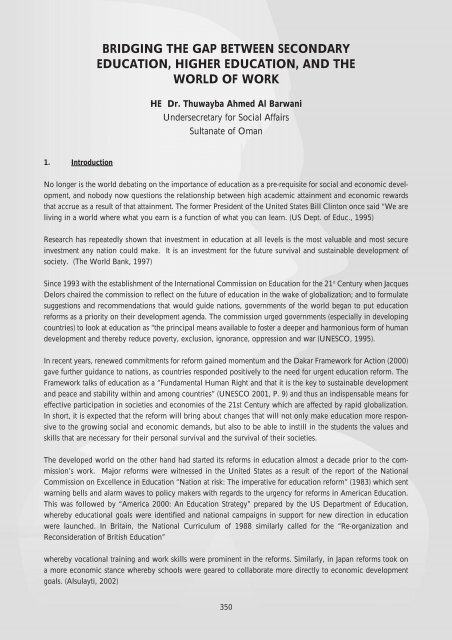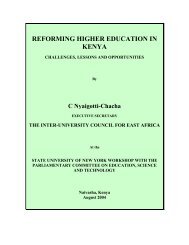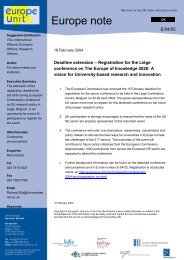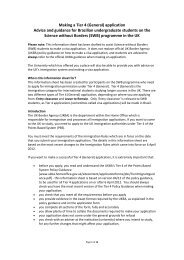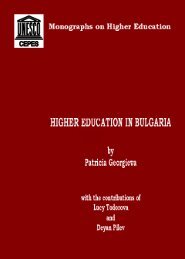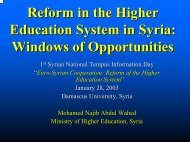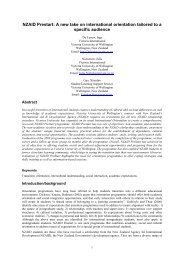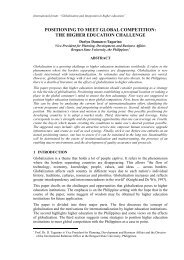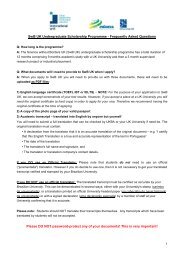bridging the gap between secondary education ... - International Unit
bridging the gap between secondary education ... - International Unit
bridging the gap between secondary education ... - International Unit
Create successful ePaper yourself
Turn your PDF publications into a flip-book with our unique Google optimized e-Paper software.
BRIDGING THE GAP BETWEEN SECONDARY<br />
EDUCATION, HIGHER EDUCATION, AND THE<br />
WORLD OF WORK<br />
HE Dr. Thuwayba Ahmed Al Barwani<br />
Undersecretary for Social Affairs<br />
Sultanate of Oman<br />
1. Introduction<br />
No longer is <strong>the</strong> world debating on <strong>the</strong> importance of <strong>education</strong> as a pre-requisite for social and economic development,<br />
and nobody now questions <strong>the</strong> relationship <strong>between</strong> high academic attainment and economic rewards<br />
that accrue as a result of that attainment. The former President of <strong>the</strong> <strong>Unit</strong>ed States Bill Clinton once said “We are<br />
living in a world where what you earn is a function of what you can learn. (US Dept. of Educ., 1995)<br />
Research has repeatedly shown that investment in <strong>education</strong> at all levels is <strong>the</strong> most valuable and most secure<br />
investment any nation could make. It is an investment for <strong>the</strong> future survival and sustainable development of<br />
society. (The World Bank, 1997)<br />
Since 1993 with <strong>the</strong> establishment of <strong>the</strong> <strong>International</strong> Commission on Education for <strong>the</strong> 21 st Century when Jacques<br />
Delors chaired <strong>the</strong> commission to reflect on <strong>the</strong> future of <strong>education</strong> in <strong>the</strong> wake of globalization; and to formulate<br />
suggestions and recommendations that would guide nations, governments of <strong>the</strong> world began to put <strong>education</strong><br />
reforms as a priority on <strong>the</strong>ir development agenda. The commission urged governments (especially in developing<br />
countries) to look at <strong>education</strong> as “<strong>the</strong> principal means available to foster a deeper and harmonious form of human<br />
development and <strong>the</strong>reby reduce poverty, exclusion, ignorance, oppression and war (UNESCO, 1995).<br />
In recent years, renewed commitments for reform gained momentum and <strong>the</strong> Dakar Framework for Action (2000)<br />
gave fur<strong>the</strong>r guidance to nations, as countries responded positively to <strong>the</strong> need for urgent <strong>education</strong> reform. The<br />
Framework talks of <strong>education</strong> as a “Fundamental Human Right and that it is <strong>the</strong> key to sustainable development<br />
and peace and stability within and among countries” (UNESCO 2001, P. 9) and thus an indispensable means for<br />
effective participation in societies and economies of <strong>the</strong> 21st Century which are affected by rapid globalization.<br />
In short, it is expected that <strong>the</strong> reform will bring about changes that will not only make <strong>education</strong> more responsive<br />
to <strong>the</strong> growing social and economic demands, but also to be able to instill in <strong>the</strong> students <strong>the</strong> values and<br />
skills that are necessary for <strong>the</strong>ir personal survival and <strong>the</strong> survival of <strong>the</strong>ir societies.<br />
The developed world on <strong>the</strong> o<strong>the</strong>r hand had started its reforms in <strong>education</strong> almost a decade prior to <strong>the</strong> commission’s<br />
work. Major reforms were witnessed in <strong>the</strong> <strong>Unit</strong>ed States as a result of <strong>the</strong> report of <strong>the</strong> National<br />
Commission on Excellence in Education “Nation at risk: The imperative for <strong>education</strong> reform” (1983) which sent<br />
warning bells and alarm waves to policy makers with regards to <strong>the</strong> urgency for reforms in American Education.<br />
This was followed by “America 2000: An Education Strategy” prepared by <strong>the</strong> US Department of Education,<br />
whereby <strong>education</strong>al goals were identified and national campaigns in support for new direction in <strong>education</strong><br />
were launched. In Britain, <strong>the</strong> National Curriculum of 1988 similarly called for <strong>the</strong> “Re-organization and<br />
Reconsideration of British Education”<br />
whereby vocational training and work skills were prominent in <strong>the</strong> reforms. Similarly, in Japan reforms took on<br />
a more economic stance whereby schools were geared to collaborate more directly to economic development<br />
goals. (Alsulayti, 2002)<br />
350
The Arab Gulf Cooperation Council States (AGCC), like many o<strong>the</strong>r countries of <strong>the</strong> world put high priority to <strong>education</strong><br />
and this is witnessed in budget allocations to <strong>education</strong>, which far exceed many countries of similar economic<br />
status. An analysis of budget allocations for <strong>education</strong> reveals that industrial countries like Belgium, Great<br />
Britain, and <strong>the</strong> Ne<strong>the</strong>rlands spend 4.9% to 8.3% of <strong>the</strong>ir GNP on <strong>education</strong>. The AGCC states spend around 3.1%<br />
to 5.8%, which means in o<strong>the</strong>r words that some of <strong>the</strong> Gulf countries like Saudi Arabia and Kuwait spend more<br />
on <strong>education</strong> than some of <strong>the</strong> countries of <strong>the</strong> European Union (Alsulayti, 2002). However, while one acknowledges<br />
progress that has been made so far, one notes that <strong>the</strong> progress has mostly focused on <strong>the</strong> quantitative development<br />
of <strong>education</strong>. Quality issues however, continue to present challenges in <strong>the</strong>se countries.<br />
Both economic and <strong>education</strong>al systems in AGCC countries are challenged to find solutions to glaring issues like:<br />
- High dependence on foreign labour<br />
- Fragile oil-based economies or rentier economies that are subject to severe insecurities as<br />
a result of fluctuating oil prices<br />
- Unemployment or ra<strong>the</strong>r un-employability of <strong>secondary</strong> school and university graduates<br />
- Social stigma attached to technical and vocational <strong>education</strong>.<br />
- Lack of involvement of o<strong>the</strong>r partners and stakeholders in <strong>the</strong> <strong>education</strong> process<br />
- Incompatibility <strong>between</strong> large budgetary allocations for <strong>education</strong> compared to its outcomes<br />
- Lack of a solid infrastructure for a “learning society”<br />
- Lack of a proper environment for creativity and personal initiatives<br />
- Lack of cooperation and coordination <strong>between</strong> national and regional structures<br />
Education reform in Oman started with <strong>the</strong> convening of <strong>the</strong> conference on 2020 vision for Oman’s economy<br />
whose outcome document was presented to <strong>the</strong> government in 1995. This vision looked at sustainable development<br />
of Oman’s economy, and gave great emphasis to human resource development which was considered<br />
to be <strong>the</strong> vital element for a sustainable development within a macro economic framework. The schools were<br />
<strong>the</strong>refore seen as necessary focus of reform. The school reform was envisioned to cover <strong>the</strong> school curriculum,<br />
school buildings, quality of teachers, school administration etc. And that was coupled with <strong>the</strong> enhancement of<br />
<strong>the</strong> relationship <strong>between</strong> <strong>the</strong> production of well developed graduates who can operate and survive in a diversified,<br />
dynamic, and globalized economy. (Ministry of Development, 1995) The government of Oman has since<br />
invested generous funds in <strong>the</strong> basic <strong>education</strong> initiative and <strong>the</strong> reform process is continuing. Anecdotal evidence<br />
available so far is reassuring, though confirmation of that will have to wait for <strong>the</strong> results of a major evaluation<br />
study expected to take place next year.<br />
1.1 Why reform in <strong>secondary</strong> <strong>education</strong><br />
Professor Bill Mulford (In UNESCO, 2001) argues that changes in <strong>the</strong> society, <strong>the</strong> economy, <strong>the</strong> work place, and<br />
<strong>the</strong> learner, demand that we take stock of what is happening and reconsider <strong>the</strong> kind of <strong>education</strong> we provide to<br />
our youth.<br />
Secondary <strong>education</strong> is no longer just a desired level of <strong>education</strong>, but it has now become a basic or an essential<br />
level for economic growth to take place. The Dakar Framework UNESCO 2000 stated that “No country can<br />
be expected to develop into a modern and open economy without having a large portion of its population completing<br />
<strong>secondary</strong> school” (In UNESCO, 2001).<br />
As societies move away from industrial economies and towards knowledge-based economies, <strong>the</strong> need for<br />
unskilled labour is now shrinking and is being rapidly replaced by technical skills, and generic skills such as adapt-<br />
351
ability, communication skills, problem solving skills, creativity, entrepreneurship and self-employment skills.<br />
These new demands require that we give high priority to <strong>secondary</strong> <strong>education</strong>, and at <strong>the</strong> same time redefine <strong>the</strong><br />
present objectives to suit <strong>the</strong> requirements of <strong>the</strong> 21st Century. Different countries of <strong>the</strong> world have responded<br />
to <strong>the</strong>se challenges in a variety of programs and initiatives. Most of <strong>the</strong>m share a number of common elements<br />
and <strong>the</strong>se can be summarized as follows:<br />
●<br />
●<br />
●<br />
●<br />
A shift towards vocational skills and a more direct response to labour market requirements<br />
Look at <strong>the</strong> learners as an adolescent who is in transition from childhood to adulthood and <strong>the</strong>refore<br />
his physical, emotional, and psychological needs are addressed<br />
Offer greater flexibility in program structure, streaming practices and selections<br />
Provide life skills<br />
The AGCC states have also faced <strong>the</strong>se challenges by introducing a number of experimental programs aimed at<br />
developing <strong>secondary</strong> <strong>education</strong>. These reform efforts, or ra<strong>the</strong>r innovations, are seen in <strong>the</strong> form of comprehensive<br />
<strong>secondary</strong> schools, which implement <strong>the</strong> credit hour system. These kinds of schools are seen mainly in<br />
Saudi Arabia and Kuwait. The objectives of <strong>the</strong>se schools are: - (1) To prepare students for an active and productive<br />
life, (2) To offer specialization tracks, (3) To give students a chance to choose preferred subjects and<br />
activities (4) To recognize and accommodate individual differences and capabilities.<br />
Ano<strong>the</strong>r type of innovation is <strong>the</strong> form of “Modern Secondary Schools” and <strong>the</strong> special feature of <strong>the</strong>se schools is<br />
to give students a choice of specialization from <strong>the</strong> following programs: Literary and Islamic Program,<br />
Administrative and Social Science Program, and <strong>the</strong> Natural Science Program. These schools were intended to: (1)<br />
introduce new programs and teaching methods, (2) offer an overall academic program that prepares <strong>the</strong> student<br />
for university <strong>education</strong> (3) offer a flexible system to prepare students for work (4) recognize individual differences.<br />
In 1999, <strong>the</strong> State of Qatar adopted a comprehensive strategy for <strong>secondary</strong> <strong>education</strong> which aims at discarding<br />
<strong>the</strong> traditional system and embarks on a system that offers specialization for grade 12 students. These specializations<br />
are: (1) Literary and Social Sciences (2) Technology and Natural Sciences (3) Economics and Administrative<br />
Sciences. Most of <strong>the</strong>se programs have not been evaluated and have so far been sporadic and in many instances<br />
cosmetic.<br />
1.2 Why reform in <strong>secondary</strong> <strong>education</strong> in Oman<br />
Secondary schools in Oman have for a long time implemented a traditional two-stream system where students<br />
are given a choice of ei<strong>the</strong>r Arts or Science stream when <strong>the</strong>y enter <strong>the</strong>ir 2nd year of <strong>secondary</strong> school. Until<br />
1988/1989 with <strong>the</strong> introduction of <strong>the</strong> two-term system at <strong>the</strong> first and second year, Oman was implementing<br />
<strong>the</strong> traditional one-year academic system where <strong>the</strong> final examination accumulated all that a student learnt<br />
throughout <strong>the</strong> year. The new system was introduced to <strong>the</strong> final year of <strong>secondary</strong> school in 1989/1990<br />
(Ministry of Education, 2001). With this system came <strong>the</strong> introduction of formative evaluation that not only recognized<br />
class work but also provided feedback to students, teachers, and parents. Little substantive changes were<br />
introduced with regard to <strong>the</strong> curriculum and teaching methods. Never<strong>the</strong>less, field research done to gauge teachers<br />
and students opinion of this new system compared to <strong>the</strong> traditional system indicated positive results in favor<br />
of <strong>the</strong> innovation (Eissan, 1990).<br />
As a result of <strong>the</strong> government’s genuine commitment to reform its system of <strong>education</strong>, and in keeping with <strong>the</strong><br />
basic <strong>education</strong> reforms that are already in place, <strong>the</strong> contemplated reforms in <strong>secondary</strong> <strong>education</strong> seems to be<br />
<strong>the</strong> natural next step. It is to be noted here that a key factor in formulating <strong>the</strong> genuine commitment to reform <strong>the</strong><br />
Omani system of <strong>education</strong> is <strong>the</strong> fact that <strong>the</strong> Ministry of Education has long known and recognized its potential<br />
of becoming a key contributor to Oman’s future stability and prosperity. The need to reform <strong>secondary</strong> edu-<br />
352
cation is also highlighted by several related research findings that are indicative of such need. Research done in<br />
Oman has indicated that our <strong>secondary</strong> schools do not adequately respond to <strong>the</strong> needs of <strong>the</strong> society. An example<br />
of such research is a survey conducted by <strong>the</strong> Shura Council where a sample of 150 research participants<br />
were asked <strong>the</strong>ir opinions regarding different elements of <strong>the</strong> present system of <strong>education</strong>. When asked whe<strong>the</strong>r<br />
<strong>the</strong>y thought that our <strong>secondary</strong> school system responds to <strong>the</strong> needs of <strong>the</strong> society, 35.3% said no, and 44% said<br />
to some extent.<br />
Some of <strong>the</strong> reasons given are:<br />
1. The inability of <strong>the</strong> <strong>secondary</strong> school graduates to be absorbed in <strong>the</strong> labour market<br />
2. Secondary school graduates are not well prepared for university <strong>education</strong><br />
3. A traditional way of teaching that relies heavily on rote-learning and does not utilize self learning strategies<br />
4. Heavy emphasis is placed on <strong>the</strong>ory and <strong>the</strong>oretical learning with no practicum<br />
5. The system does not follow recent advances in science and technology<br />
6. Failure to develop <strong>the</strong> students’ English language skills - highly evident in students’ persistent weakness in <strong>the</strong><br />
English language<br />
7. Preference given to quantity ra<strong>the</strong>r that quality in teaching and learning, especially in subjects such as geography<br />
and physics for <strong>the</strong> third year students<br />
8. Overall weakness in <strong>the</strong> scientific level of <strong>secondary</strong> school graduates<br />
9. Teachers are not periodically refreshed in <strong>the</strong>ir particular subjects<br />
10. Teachers are constantly overburdened by procedural and administrative issues, and <strong>secondary</strong> school teachers<br />
are constantly being changed or replaced<br />
11. The <strong>secondary</strong> school certificate exams are difficult and different<br />
12. A prevalent attitude of forcing <strong>the</strong> student to learn instead of raising his/her interest in learning. Therefore,<br />
<strong>education</strong> becomes a frustrating ra<strong>the</strong>r than an interesting experience<br />
13. Little or no freedom for <strong>the</strong> student to choose <strong>between</strong> <strong>the</strong> scientific and <strong>the</strong> literary sections<br />
14. Taught subjects are too lengthy compared to <strong>the</strong> length of <strong>the</strong> academic year<br />
15. Shortage in instructional media, and <strong>the</strong> inability to keep up with <strong>the</strong> advances in <strong>education</strong>al technology<br />
16. Weakness in applying <strong>the</strong> rules and regulations<br />
Being a Gulf country, Oman faces similar challenges as those that confront o<strong>the</strong>r AGCC states. However, Oman<br />
has some o<strong>the</strong>r challenges that seem to be specific to it. The most important of <strong>the</strong>se challenges are summarized<br />
as follows:<br />
- An unusual population distribution - Census statistics show that those under 18 years of age comprise 60%<br />
of <strong>the</strong> total Omani population (Ministry of National Economy, 2000)<br />
- Inability of <strong>the</strong> labour market to absorb graduates of <strong>secondary</strong> <strong>education</strong>. Analysis of <strong>the</strong> labour market<br />
situation in Oman, studies on Omanization; toge<strong>the</strong>r with <strong>the</strong> 2001 seminar on <strong>the</strong> employment of <strong>the</strong><br />
Omani manpower, have all shown that only a small percentage of <strong>secondary</strong> school graduates have been<br />
absorbed by <strong>the</strong> labour market, while until <strong>the</strong> end of 2001 expatriates continue to dominate <strong>the</strong> private<br />
sector’s labour market with <strong>the</strong>ir participation rates reaching 89.8% (Ministry of National Economy, 2001).<br />
- Inability of <strong>the</strong> existing higher <strong>education</strong> institutions to absorb <strong>secondary</strong> school graduates. Analyses of<br />
<strong>secondary</strong> school students statistics provided by <strong>the</strong> Ministry of Education and coupled with <strong>the</strong> absorption<br />
capacity of higher <strong>education</strong> institutions have all shown that <strong>the</strong> existing institutions, both government<br />
and private (including scholarships abroad), absorbed only 44% of <strong>the</strong> total number of students who graduated<br />
in 2000/2001 academic year, and that this number represents only 12.6% of <strong>the</strong> total population of<br />
353
18-24 age group. (Ministry of Education, 2001)<br />
- High cost of higher <strong>education</strong>: Higher <strong>education</strong> institutions carry a considerable burden in order to correct<br />
short falls in <strong>education</strong> provision at <strong>the</strong> <strong>secondary</strong> level. This is evidenced in <strong>the</strong> government spending<br />
per student that reaches over Omani Rials 5,000. (Approx.$14400.00) The consequences of students<br />
inadequate preparation is manifested in student’s inability to comply with high level academic requirements<br />
such as study skills, research skills, language skills, and more importantly <strong>the</strong> right attitude to learn.<br />
This has necessitated <strong>the</strong> introduction of <strong>the</strong> foundation program, tutorials, prolonged English language<br />
programs, etc. (World Bank, 2000)<br />
- The employer bears high cost of training: Because <strong>secondary</strong> school graduates do not possess any work<br />
skills when <strong>the</strong>y graduate, <strong>the</strong> employer has to bear direct costs of training or bear <strong>the</strong> indirect cost of supporting<br />
training programs by contributing specified amounts towards vocational training<br />
- Work-type entrapment of <strong>secondary</strong> school graduates: Most employed <strong>secondary</strong> school graduates are<br />
trapped in intermittent low paying jobs that provide no economic security or opportunity for personal<br />
development. This has led to employees’ dissatisfaction, low productivity, and high turnover of Omani<br />
manpower.<br />
- A large number of <strong>secondary</strong> school students who did not pass are unable to be absorbed in <strong>the</strong> labour<br />
force: The number of <strong>the</strong>se students increases annually and <strong>the</strong>ir cumulative total pauses a danger of<br />
becoming a social and political time bomb.<br />
The aforementioned inconsistencies seem to indicate that our <strong>secondary</strong> school program needs a thorough investigation<br />
and <strong>the</strong> issues presented above need to be resolved in order for our <strong>secondary</strong> schools to be in a position<br />
to bear <strong>the</strong> burden of <strong>the</strong> responsibility that is entrusted to it.<br />
This paper <strong>the</strong>refore, is an attempt to address <strong>the</strong>se challenges in <strong>the</strong> context of Oman’s vision of its socio-economic<br />
development, its position in <strong>the</strong> world, and its urgent need to resolve some of <strong>the</strong> issues that confront<br />
educators as <strong>the</strong>y embark on <strong>the</strong> reform process. Specifically, this paper will look at <strong>the</strong> labour market and try<br />
to identify possible explanations as to why <strong>secondary</strong> school graduates do not get absorbed in <strong>the</strong> labour market<br />
despite our heavy dependence on <strong>the</strong> expatriate labour force. What role does <strong>the</strong> <strong>secondary</strong> school program<br />
have in preparing our youth for work and life outside <strong>the</strong> school The paper will also look at student admission<br />
at higher <strong>education</strong> institutions and will attempt to identify possible explanations as to why <strong>secondary</strong> school<br />
graduates who do get admission in higher <strong>education</strong> institutions also have difficulty in coping with academic<br />
demands of higher <strong>education</strong>. What role does <strong>the</strong> <strong>secondary</strong> school have in preparing our youth as thinkers, scientists,<br />
and leaders of tomorrow<br />
Based on <strong>the</strong> aforementioned questions <strong>the</strong> paper will explore models and practices that could contribute some<br />
solutions to <strong>the</strong> challenges that confront us today.<br />
2. Manpower Development and Labour Market Demands<br />
A look at <strong>the</strong> present <strong>secondary</strong> school system in Oman reveals a number of assumptions regarding <strong>the</strong> role of<br />
<strong>secondary</strong> schools. The one single role that seems to be reinforced more than o<strong>the</strong>rs is “Preparation for admission<br />
to higher <strong>education</strong> institutions”. This is because our system offers only academic subjects, which suggests<br />
that our students are a homogeneous group who all want and can get admission into higher <strong>education</strong> institutions,<br />
and that those who do not will automatically be absorbed in <strong>the</strong> labour market which is in keeping with<br />
<strong>the</strong> Omanization policy. This assumption is reflected in <strong>the</strong> subjects offered which give little or no recognition to<br />
individual differences, personal choice, career preparation, skills, or vocational training.<br />
354
Analyses of Ministry of Higher Education statistics shows that even though all students are prepared for higher<br />
<strong>education</strong> institutions, less than half of <strong>the</strong>m actually get admitted into higher <strong>education</strong>. A look at 2002 statistics<br />
shows that out of a total of almost 34,000 students who passed in <strong>secondary</strong> school certificate examination, only<br />
41.6% were admitted in higher <strong>education</strong> and vocational training programs; leaving almost 60% of successful<br />
students without an opportunity for training. These graduates <strong>the</strong>refore head to <strong>the</strong> labour market.<br />
Fur<strong>the</strong>r analysis of <strong>the</strong>se statistics shows that as <strong>the</strong> number of <strong>secondary</strong> school graduates increases, <strong>the</strong> less is<br />
<strong>the</strong> chance for fur<strong>the</strong>r <strong>education</strong> and training. Statistics of 2000 and 2001 seem to illustrate this point when a total<br />
of 27,419 graduated, 45.9% found places in higher <strong>education</strong> institutions. This percentage decreases as <strong>the</strong> number<br />
of graduates increases as shown by statistics of 2001 and 2002 (see table I)<br />
Table1. Distribution of students passing <strong>the</strong> <strong>secondary</strong> school certificate<br />
Categories 2000 2001 2002 (end of August)<br />
Total number passing <strong>secondary</strong> school certificate 27,037 32,211 33,972<br />
Total number admitted to Higher and Vocational Education 12,419 13,335 14,138<br />
(45.9%) (41.4%) (41.6%)<br />
Total number expected to enter <strong>the</strong> labour market 14,618 18,876 19,834<br />
Source: Ministry of National Economy, 2002<br />
Projections done by <strong>the</strong> Ministry of Higher Education seem to indicate that <strong>the</strong> situation will be even more serious<br />
towards <strong>the</strong> end of this planning period 2005/2006 where <strong>the</strong> percentage of those admitted in higher <strong>education</strong><br />
institutions will not exceed 37.6%.<br />
Analysis of <strong>the</strong> Work Force Survey of 1996 shows that <strong>secondary</strong> school graduates constitute 18.9% of <strong>the</strong> total<br />
workforce. Only 15.5% of <strong>secondary</strong> school graduates are employed leaving 35.3% unemployed youth. With an<br />
increasing number of students graduating each year and with limited opportunities in <strong>the</strong> job market (in <strong>the</strong> public<br />
and private sectors), one assumes that <strong>the</strong> cumulative number of unemployed youth who are not absorbed by<br />
<strong>the</strong> labour market will gradually increase.<br />
355
Table 2: The Omani Workforce distributed according to level of <strong>education</strong><br />
Type of Education Total Work Force (%) Employed% Unemployed%<br />
Preparatory or Less 69.8 71.8 60.3<br />
Secondary 18.9 15.5 35.3<br />
Intermediate and Technical Colleges 7.0 7.8 3.1<br />
University 4.3 4.9 1.3<br />
Total 100.0 100.0 100.0<br />
Source: Ministry of National Economy, 2000<br />
This table shows that <strong>the</strong> bulk (69.8%) of total Omani workforce possesses preparatory or a level of <strong>education</strong><br />
that is less than that. This indicates among; o<strong>the</strong>r things that <strong>the</strong> jobs occupied by this group of Omanis would<br />
most likely be low paying and low status jobs like messengers, security men, gardeners, cleaners, etc.<br />
The numbers that we have discussed so far have only been for students who pass <strong>the</strong> <strong>secondary</strong> school certificate.<br />
With a failure rate of 21.8% annually one could extrapolate that our <strong>secondary</strong> schools produce an additional<br />
21.8% job seekers (see table 3).<br />
Table 3: Secondary School Certificate Results (2001-2002)<br />
Type of school<br />
Registered<br />
Approved<br />
Appeared<br />
Passed<br />
Failed<br />
Male Female Male Female Male Female Male Female<br />
Public schools<br />
Science<br />
Arts<br />
Adult Center<br />
Science<br />
Arts<br />
Private Schools<br />
Science<br />
Arts<br />
Total<br />
8,179 8,286 7,947 8,066 6,617 7,627 1,562 659<br />
5849 6774 5726 6597 4787 6295 1060 479<br />
1317 2928 823 2277 615 2,122 702 806<br />
2620 3869 1836 3212 1487 3118 1133 751<br />
64 24 63 24 61 21 3 3<br />
7 7 9 7 6 7 3 -<br />
18,038 21,888 16,404 20,183 13,575 19,189 4,463 2,698<br />
Source: Ministry of Education, 2002<br />
Table 3 clearly shows <strong>the</strong> increasing number of registered, passed, and failed students in <strong>secondary</strong> school certificate<br />
examination. The failed students, who can nei<strong>the</strong>r be accepted in higher <strong>education</strong> institutions nor <strong>the</strong> job<br />
market, present a potential risk as <strong>the</strong>y are prone to revert to socially unacceptable behaviors that may have serious<br />
repercussions. This group of expels, toge<strong>the</strong>r with those who passed but cannot find something to do, needs<br />
to be seriously considered while we look at options for <strong>secondary</strong> school of <strong>the</strong> 21st Century.<br />
Analysis of labour market statistics shows that while <strong>the</strong> number of Omani males and females who enter <strong>the</strong><br />
labour market is gradually increasing, <strong>the</strong> total number cannot be compared with <strong>the</strong> expatriate workforce. Table<br />
4 shows <strong>the</strong> growth of Omani workforce <strong>between</strong> <strong>the</strong> years 1993 to 1999.<br />
356
Table 4: Omani Workforce and <strong>the</strong> Percentage of Male/Female Economic Participation (1993-1999)<br />
Years % Percentage of Raw Participation Workforce (* by Thousands)<br />
Males Females Total Males Females Total<br />
1993 32.9 3.2 18.4 248.9 23.5 272.4<br />
1996 32.2 5.1 19.0 264.4 40.3 304.7<br />
1997 35.8 5.6 21.0 299.0 45.6 344.6<br />
1998 36.7 5.9 21.5 314.7 48.6 363.3<br />
1999 37.7 6.1 22.1 330.8 51.6 382.4<br />
Source: Ministry of National Economy (1999)<br />
A fur<strong>the</strong>r look at this table also shows that females are at a disadvantage as <strong>the</strong>ir participating rate reaches only<br />
6.1% in 1999.<br />
Recent statistics from <strong>the</strong> Ministry of National Economy (Ministry of National Economy, 2002) shows that expatriates<br />
constitute 530.000 workers in <strong>the</strong> private sector workforce, while <strong>the</strong> Omani males and females contribute<br />
only 60,487, thus making a mere 11.4% of <strong>the</strong> total workforce.<br />
Tables 5 bellow shows that <strong>the</strong> expatriate workforce continues to increase despite <strong>the</strong> increase of both male and<br />
female Omani nationals. The table fur<strong>the</strong>r shows that females contribute only 1.8% of <strong>the</strong> total private sector<br />
workforce.<br />
Source: Ministry of National Economy, 2001<br />
Table 5: Private Sector Employment (1999-2001)<br />
2001 2000 1999<br />
Omanis total 60,487 55,671 50,660<br />
Males 49,584 45,623 41,910<br />
Females 10,903 10,048 8,750<br />
Expatriates total 530,000 495,000 475,000<br />
Total 590,487 550,671 525,660<br />
A deeper look at <strong>the</strong> Expatriate labour force reveals that of <strong>the</strong> total number of expatriates in <strong>the</strong> labor market,<br />
45,000 of <strong>the</strong>m possess <strong>secondary</strong> school certificates while <strong>the</strong> majority would have below <strong>secondary</strong> school certificates<br />
(see table 6).<br />
Table 6: Expatriates employment in <strong>the</strong> Private Sector by level of Education<br />
Total Number by level of <strong>education</strong> 2000 2001 2002 (end of August)<br />
All levels of <strong>education</strong> 494,699 529,998 539,659<br />
Secondary school level (only) 45,808 46,705 45,665<br />
Ministry of National Economy, 2002<br />
The picture in <strong>the</strong> Public Sector is more encouraging; however, <strong>the</strong> potential for growth in this sector is limited<br />
due to limitations in job creation. Table 7 shows Omani and Expatriate Employment trends in <strong>the</strong> public sector.<br />
357
Table 7: Omani and Expatriate Employees in <strong>the</strong> Public Sector*<br />
(1999-2001)<br />
SECTOR 2001 2000 1999<br />
Civil Service Total 88,000 85,000 83,000<br />
Omanis 68,000 64,000 60,00<br />
Expatriates 20,000 21,000 23,000<br />
Diwan of Royal Court Total 19,000 18,000 18,000<br />
Omanis 13,000 12,000 12,000<br />
Expatriates 6,000 6,000 6,000<br />
Public Cooperation Total 8,000 8,000 8,000<br />
Omanis 6,000 6,000 5,000<br />
Expatriates 2,000 2,000 3,000<br />
Total Omanis 87,000 82,000 77,000<br />
Total Expatriates 28,000 29,000 32,000<br />
Total Public sector workforce 115,000 111,000 109,000<br />
Source: Ministry of National Economy, 2001 - * Does not include Armed Forces, Royal Omani Police, and personnel<br />
of o<strong>the</strong>r security organs.<br />
Analysis of table 7 shows that <strong>the</strong> number of Omanis employed in <strong>the</strong> public sector exceed that of expatriates<br />
though expatriates still contribute almost a third to <strong>the</strong> public sector workforce. It is important to note here that<br />
<strong>the</strong> majority of <strong>the</strong> expatriates who work in <strong>the</strong> public sector are employed in highly paid, prestigious professions<br />
like medical doctors, university and college professors, consultants, experts etc...<br />
A look at <strong>the</strong> distribution of <strong>the</strong> labour force by occupation (see table 8) shows that most of <strong>the</strong> expatriates<br />
employed in Oman work in <strong>the</strong> occupational category of artisans (33.3% of <strong>the</strong> total expatriate employees), followed<br />
by services (20.9%). Recent statistics have shown some improvement though expatriates continue to dominate<br />
<strong>the</strong>se work categories (Ministry of National Economy, 2000).<br />
Source: Ministry of National Economy, 1993<br />
Table 8: Percentage distribution of <strong>the</strong> labour force<br />
Occupation 1993<br />
% Omani % Expatriate<br />
Legal Experts, Senior Civil Servants and Directors 4.6 2.1<br />
Specialists 7.6 10.4<br />
Technicians and Assistant Specialists 16.8 3.5<br />
Services 20.6 20.9<br />
Skilled Agricultural laborers 8.6 1.3<br />
Professionals, Artisans 4.9 33.3<br />
Machine Operators 9.7 9.9<br />
Marginal Occupations 14.1 15.2<br />
O<strong>the</strong>r unspecified occupations 1.3 0.4<br />
Total 100 100<br />
The above discussion seems to indicate that <strong>the</strong> reason for <strong>the</strong> inability of <strong>the</strong> labour market to absorb <strong>secondary</strong><br />
school graduates is not based on <strong>the</strong> unavailability of jobs, nor is it based on <strong>the</strong> level of <strong>education</strong> required by<br />
358
<strong>the</strong> labour market. Ra<strong>the</strong>r, it is based on <strong>the</strong> skills, attitudes, and experience required by <strong>the</strong> labour market, and<br />
which seem to be provided by <strong>the</strong> expatriate workforce and not by our <strong>secondary</strong> school graduates.<br />
A thorough look at <strong>the</strong> options offered to our students in terms of subjects taught, method of teaching, method of<br />
evaluation, all seem to confirm that <strong>the</strong>se factors have contributed to <strong>the</strong> weak profile of <strong>the</strong> Omani <strong>secondary</strong><br />
school graduate, and his/her lowered performance in <strong>the</strong> labour market. This weak profile seems to have resulted<br />
in <strong>the</strong> employers’ lack of confidence in <strong>the</strong> Omani labour force. Despite government intervention in baring<br />
expatriates from working in specified occupations, <strong>the</strong> turnover rate of Omanis in <strong>the</strong>se occupations has been<br />
high and <strong>the</strong>ir productivity has been low.<br />
It is to be stressed here that <strong>the</strong> repercussions of this would undoubtedly be slow economic growth, low foreign<br />
investment, and high youth unemployment coupled with new social challenges that might follow...<br />
3. Higher Education Institutions and <strong>the</strong> Academic demands<br />
The most apparent objective of <strong>secondary</strong> <strong>education</strong> in Oman has consistently been <strong>the</strong> preparation of students<br />
for admission in higher <strong>education</strong> institutions.<br />
This objective reflects a number of underlying assumptions:<br />
1. All students enter higher <strong>education</strong> institutions<br />
2. There is only one type of student ... The one who is able to pass <strong>the</strong> <strong>secondary</strong> school certificate<br />
examination, which is based on <strong>the</strong> achievement of subject matter taught in <strong>the</strong> final year of <strong>the</strong><br />
<strong>secondary</strong> cycle<br />
3. All students want and can pursue higher <strong>education</strong>.<br />
4. The <strong>secondary</strong> school certificate examination is <strong>the</strong> only reliable measure of a student’s ability.<br />
5. It is not <strong>the</strong> school responsibility to equip <strong>the</strong> students with social skills and develop <strong>the</strong>ir sense<br />
of social responsibility.<br />
6. It is not <strong>the</strong> school responsibility to raise <strong>the</strong> students’ awareness of issues that would help <strong>the</strong>m<br />
move smoothly from adolescence to adulthood<br />
If <strong>the</strong>se assumptions were correct, one would expect that <strong>the</strong> group of students who do get admission in higher<br />
<strong>education</strong> institutions would be able to perform at an academic standard that is consistent with expectations of<br />
<strong>the</strong> receiving institution. Research done at <strong>the</strong> Sultan Qaboos University (SQU), Colleges of Education, and <strong>the</strong><br />
College of Technology, all seem to be telling a different story.<br />
Students’ admission into higher <strong>education</strong> institutions seems to be related to an issue that is at once philosophical<br />
and economical at <strong>the</strong> same time. It is also both a quantitative and a qualitative issue; hence, a look into <strong>the</strong><br />
issue of students’ absorption in higher <strong>education</strong> institutions is warranted.<br />
3.1 The absorption capacity of Higher Education Institutions<br />
The absorption capacity is normally based on <strong>the</strong> government’s ability and willingness to invest in higher <strong>education</strong>.<br />
This position is mainly guided by <strong>the</strong> philosophical argument of whe<strong>the</strong>r or not higher <strong>education</strong> is a right<br />
of every student who passes <strong>the</strong> <strong>secondary</strong> school certificate examination. When this position is adopted, <strong>the</strong> government<br />
makes available higher <strong>education</strong> opportunities for all successful students who wish to pursue higher<br />
<strong>education</strong>. A look at <strong>the</strong> number of students graduating from <strong>secondary</strong> schools and <strong>the</strong> absorption of <strong>the</strong>se students<br />
in higher <strong>education</strong> institutions shows that in 2001/2002 only 44% of <strong>the</strong> graduating students could be<br />
absorbed by <strong>the</strong> private and public higher <strong>education</strong> institutions including scholarships abroad. Table 9 below<br />
shows <strong>the</strong> absorption capacity of all higher <strong>education</strong> institutions in <strong>the</strong> Sultanate.<br />
359
Table 9: Number of students admitted to higher Education Institutions 2000-2002<br />
Institution/scholarship 2000/2001 2001/2002<br />
Sultan Qaboos University 2,038 2,231<br />
Colleges of Education 1,997 2,000<br />
Law and Shariya College 128 170<br />
Scholarships and Special grants abroad 157 330<br />
Accounting Diploma (SQU) 575 454<br />
Technical Colleges 2,088 2,204<br />
Health Institutes 694 694<br />
Institute of Banking and Financial Studies 90 116<br />
Private Institutes (NVQ Program) 567 780<br />
Govt. Scholarships in Private Colleges 1,500 1,700<br />
P.D.O scholarships 30 27<br />
Institute of Islamic Jurisprudence 59 50<br />
Institute of Tourism - 217<br />
Total 9,923 10,973<br />
Source: Ministry of National Economy, 2002<br />
Statistics provided by <strong>the</strong> Ministry of Higher Education show that for <strong>the</strong> academic year 2002/2003, if <strong>the</strong> situation<br />
remains as it is today, <strong>the</strong> higher <strong>education</strong> institutions will absorb only 10,917 students. This number makes<br />
only 42% of those who have passed. It is fur<strong>the</strong>r predicted that if <strong>the</strong> situation persists and <strong>the</strong> numbers who graduate<br />
increases, only 39% of those who pass will be absorbed by <strong>the</strong> higher <strong>education</strong> institutions in 2002/2004.<br />
By <strong>the</strong> end of <strong>the</strong> 6 th year plan (2005/2006), only 37.6% of <strong>the</strong> passing students will be absorbed.<br />
Following <strong>the</strong> analysis of this data, one could safely conclude that <strong>the</strong> absorption capacity is restricted by <strong>the</strong> economic<br />
situation in Oman, toge<strong>the</strong>r with <strong>the</strong> government’s position regarding <strong>the</strong> philosophy of selective higher<br />
<strong>education</strong>. For Oman, <strong>the</strong>refore, <strong>the</strong> issue of quality would seem to take precedence over quantity. Increasingly<br />
larger number of students will continue to compete for a small number of places available in Higher Education<br />
institutions. Under <strong>the</strong>se circumstances, one would assume that only <strong>the</strong> very best of <strong>secondary</strong> school graduates<br />
actually find <strong>the</strong>ir way to higher <strong>education</strong> institutions.<br />
3.2 Secondary school certificate results as a criterion for admission in higher <strong>education</strong> institutions.<br />
The only criterion used to determine whe<strong>the</strong>r a student qualifies for admission is <strong>the</strong> <strong>secondary</strong> school certificate<br />
examination results. This examination is set on <strong>the</strong> basis of subjects learnt in <strong>the</strong> final year. Through <strong>the</strong><br />
years, <strong>the</strong> examination has been criticized for being information-based and that it does not test higher-level cognitive<br />
skills. Students are prepared for an examination that emphasizes memorization of facts ra<strong>the</strong>r than problem<br />
solving and analytical skills. Research done in developing countries has revealed that <strong>secondary</strong> exit examination<br />
results have poor predictive validity, and students’ marks are not necessarily reliable predictors of <strong>the</strong>ir university<br />
or later job/income success (UNESCO, 2001).<br />
A study conducted at Sultan Qaboos University (1997) to assess <strong>the</strong> performance of students has indicated that<br />
<strong>the</strong>ir performance at SQU fails to match that at <strong>the</strong> <strong>secondary</strong> school as determined by <strong>the</strong> <strong>secondary</strong> school<br />
examination results. Results fur<strong>the</strong>r indicated that <strong>the</strong> correlations <strong>between</strong> <strong>secondary</strong> school certificate results<br />
and college GPA were not significant (Alshahwarzi, 1991). A similar study to investigate <strong>the</strong> validity of <strong>the</strong> claim<br />
that <strong>secondary</strong> school certificate grades are not good predictors of success at <strong>the</strong> university (1993) has confirmed<br />
that <strong>the</strong> <strong>secondary</strong> school certificate examination is not <strong>the</strong> sole predictor of university grades. Findings seem to<br />
suggest that o<strong>the</strong>r variables both cognitive and non-cognitive may be contributing factors to student success at <strong>the</strong><br />
university (Ibrahim, 1993)<br />
360
The questions raised by <strong>the</strong>se investigations lead one to wonder whe<strong>the</strong>r <strong>the</strong> reason could be because <strong>the</strong> students<br />
were not adequately prepared at <strong>the</strong> <strong>secondary</strong> level, or that <strong>the</strong> expectations at higher <strong>education</strong> institutions<br />
are much higher than <strong>the</strong> level at which students exit from <strong>the</strong> <strong>secondary</strong> school.<br />
Fur<strong>the</strong>r investigations done at <strong>the</strong> university to determine <strong>the</strong> specific skills that negatively impact on students’<br />
achievement at <strong>the</strong> university have shown that <strong>the</strong> most important factor as perceived by faculty members is <strong>the</strong><br />
weakness of <strong>the</strong> students’ previous preparation at <strong>the</strong> <strong>secondary</strong> school. This factor had <strong>the</strong> highest mean of 4.14<br />
and standard deviation 0.96. It was followed by students’ weakness in self-learning skills, lack of internal motivation<br />
to learn skills, lack of self-reliance, a student’s inability to manage his time, weakness in English language,<br />
and <strong>the</strong> students’ inability to properly take notes in class (Albarwani, 1993).<br />
Table 10: Factors that negatively influence student performance at Sultan Qaboos University<br />
as perceived by faculty members<br />
FACTORS MEAN SD<br />
Weakness in academic preparation at <strong>the</strong> <strong>secondary</strong> school 4.14 0.96<br />
Weakness in self learning skills 4.02 1.00<br />
Lack of achievement motivation 3.98 1.10<br />
Lack of self reliance and independence 3.94 1.21<br />
Lack of time management skills 3.82 1.03<br />
Lack of interest and motivation in <strong>the</strong> area of specialization 3.79 1.21<br />
Low English language proficiency 3.64 1.30<br />
Lack of Notes-Taking Skills during Lectures 3.62 1.19<br />
Lack of exposure to academic requirements of university study 3.60 1.20<br />
Lack of appreciation of <strong>the</strong> importance of what <strong>the</strong>y are learning at <strong>the</strong> University 3.57 1.07<br />
Table 10 shows ten highest rated skills that hinder student performance at <strong>the</strong> university. Faculty at Sultan<br />
Qaboos University believe that <strong>the</strong>se skills aught to be part of <strong>the</strong> students <strong>secondary</strong> school preparation. A look<br />
at <strong>the</strong> students’ opinion reveals that <strong>the</strong> negative factors shows a completely different picture with high priority<br />
given to course content, method of teaching, and evaluation. The result of this study seem to show that <strong>the</strong> student<br />
is faced with tremendous pressure in coping with academic demands of university study, and has difficulty<br />
in making a smooth transition from <strong>secondary</strong> school to university.<br />
In ano<strong>the</strong>r Study conducted at SQU (Albarawani, 1997), Faculty were given a list of 34 skills and were asked to<br />
rate <strong>the</strong>m based on two scales- importance and availability. On <strong>the</strong> importance scale <strong>the</strong> results show 76.5% of<br />
<strong>the</strong> postulated skills having high ratings with “interest and motivation to learn” taking <strong>the</strong> first priority. This was<br />
followed by high-level cognitive skills such as logical organization of information, application, syn<strong>the</strong>sis, critical<br />
thinking. Regularity in doing assignment and class attendance was also rated high on <strong>the</strong> degree of importance.<br />
At <strong>the</strong> lower end were skills such as <strong>the</strong> “ability to memorize and recall information”, and “adjustment to university<br />
environment”. See table 11<br />
361
Table 11: Basic skills for university study rated according to degree of importance as perceived by<br />
faculty members<br />
Rank Skills Average Std. dev<br />
1 Interest and motivation to learn 4.70 .63<br />
2 Ability to organize ideas logically 4.49 .86<br />
3 Regularity in doing assignments 4.49 .72<br />
4 Ability to apply knowledge 4.46 .80<br />
5 Ability to syn<strong>the</strong>size and integrate elements of knowledge 4.45 .73<br />
6 Ability for critical thinking 4.42 .77<br />
7 Punctuality and regularity in class attendance 4.41 .88<br />
8 Realization that responsibility for academic achievement lies with students 4.41 .75<br />
9 Proper pre-university preparation in subject-matter 4.37 .91<br />
10 Ability for written communication 4.35 .76<br />
When faculty member were asked to rank <strong>the</strong>se skills according to <strong>the</strong>ir availability among Sultan Qaboos<br />
University students, <strong>the</strong> results showed high-level cognitive skills as being <strong>the</strong> least available. Table12 shows<br />
some of <strong>the</strong> least available skills and attitudes<br />
Table 12: Basic skills for university study ranked according to degree of unavailability in students<br />
as perceived by faculty members<br />
Rank Skills Average Std. dev<br />
1 Extent of outside reading 1.80 .93<br />
2 Ability to read fast with concentration 1.96 .89<br />
3 Ability to locate and use additional information o<strong>the</strong>r than that provided in class 2.05 .89<br />
4 Frequency in using <strong>the</strong> library 2.05 .97<br />
5 Ability to think inductively 2.21 .89<br />
6 Ability for critical thinking 2.25 .89<br />
7 Ability to think deductively 2.29 .89<br />
8 Ability to take notes during lectures 2.30 1.08<br />
9 Ability to use <strong>the</strong> library 2.39 .98<br />
10 Ability for written communication 2.41 .97<br />
11 Ability for objective discussion 2.42 .95<br />
12 Ability to summarize information 2.43 .87<br />
13 Ability to syn<strong>the</strong>size and integrate elements of knowledge 2.47 .86<br />
14 Time management and planning 2.50 .95<br />
15 Ability to apply knowledge and skills 2.51 .87<br />
Source: Albarawani, 1997<br />
One notes here that <strong>the</strong> least available skills and attitudes are those that involve high-level cognitive skills. It is<br />
of particular interest to see that <strong>the</strong> only cognitive skill that was judged as available among <strong>the</strong> students was “The<br />
ability to memorize and recall information”. The rest of <strong>the</strong> available skills were related to discipline, respect,<br />
observance of rules and regulations, punctuality etc. Fur<strong>the</strong>r inspection of <strong>the</strong> results show that this situation holds<br />
true for <strong>the</strong> students of all colleges.<br />
In order to solve <strong>the</strong> existing discrepancy <strong>between</strong> what is essential and what is available, <strong>the</strong> concerned<br />
researchers proposed an introduction of a “study skills course” to be offered to first year students. This course was<br />
362
intended to inculcate in newly admitted students <strong>the</strong> skills and attitudes that are needed in university study. It<br />
was seen that <strong>the</strong> skills to be emphasized would be high-level cognitive skills toge<strong>the</strong>r with verbal and written<br />
communication skills. The above-mentioned research work has not only identified <strong>the</strong> <strong>gap</strong>, but has also proposed<br />
solutions - albeit temporary solutions to compensate <strong>the</strong> inadequate skills among our students.<br />
Similar compensatory solutions and remedial programs have been initiated at <strong>the</strong> University and o<strong>the</strong>r higher<br />
<strong>education</strong> institutions. The “foundation year” concept was one such initiative in Sultan Qaboos University, which<br />
turned out to be heavily dominated by <strong>the</strong> English Language program. Prior to <strong>the</strong> opening of <strong>the</strong> University a<br />
number of studies were conducted by <strong>the</strong> SQU foundation committee to determine <strong>the</strong> level at which students<br />
exit <strong>the</strong> <strong>secondary</strong> school level. Results of <strong>the</strong>se studies have shown a <strong>gap</strong> <strong>between</strong> <strong>the</strong> levels at which <strong>the</strong> university<br />
was expected to operate and <strong>the</strong> reality of students’ capability when <strong>the</strong>y finish <strong>secondary</strong> school (SQU<br />
University Project, 1983).<br />
It was realized very early in <strong>the</strong> planning stage that a compensatory English Language program for <strong>the</strong> new<br />
entrants was inevitable if <strong>the</strong> university where to maintain high standards, with time this program became one of<br />
<strong>the</strong> major budgetary challenges and a source of students’ contention. English Language proficiency tests used to<br />
stream students have consistently shown that <strong>the</strong> majority of <strong>the</strong> students rank at “Band I” which is <strong>the</strong> lowest<br />
level of proficiency. The English Language course developed <strong>the</strong>refore from being a program meant to improve<br />
English language proficiency for one or two semesters to becoming a full-blown program that tackled besides language<br />
proficiency, o<strong>the</strong>r skills such as note taking, summarizing information, presentation skills, group work etc.<br />
This led to a prolonged program that added to <strong>the</strong> overall cost per student.<br />
From <strong>the</strong> date of its inception, <strong>the</strong> university was declared to be an institution of higher learning that would<br />
address itself to <strong>the</strong> needs of Oman according to <strong>the</strong> highest modern international standards. From <strong>the</strong> outset, <strong>the</strong><br />
university declared that it would not compromise quality and would take all measures to ensure that <strong>the</strong> graduates<br />
of this university were ready to take leadership roles in <strong>the</strong> development of modern Oman (SQU University<br />
Project, 1983)). As a result of <strong>the</strong> rigorous academic demands, students admitted to <strong>the</strong> University had to undergo<br />
an extensive adjustment period for which a number of students were unable to comply and subsequently fell<br />
<strong>between</strong> <strong>the</strong> cracks. This was manifested in repeated failure, withdrawals, low GPAs upon graduation, and delays<br />
in graduation thus adding to <strong>the</strong> overall government spending.<br />
The World Bank report on <strong>the</strong> “Cost Effectiveness Study for <strong>the</strong> Education Sector” (2000) has indicated that a<br />
major portion of <strong>the</strong> solution to <strong>the</strong> <strong>education</strong> cost related problems lies within <strong>the</strong> realm of <strong>secondary</strong> <strong>education</strong>.<br />
The report pointed out that improvements in quality of <strong>secondary</strong> <strong>education</strong> could eliminate or reduce <strong>the</strong><br />
need for a foundation year at both private colleges and Sultan Qaboos University thus cutting costs and making<br />
<strong>the</strong> university more efficient in fulfilling its mission, and in providing its students with a more enjoyable higher<br />
learning experience.<br />
4. Bridging <strong>the</strong> <strong>gap</strong> <strong>between</strong> <strong>secondary</strong> <strong>education</strong> and <strong>the</strong> world of work<br />
Now that <strong>the</strong> <strong>gap</strong> has been identified, how can it be bridged What changes need to be implemented in order<br />
to make <strong>secondary</strong> <strong>education</strong> a true preparation for work What kind of program would ensure that our students<br />
possess <strong>the</strong> skills necessary to enable <strong>the</strong>m to occupy <strong>the</strong> jobs currently taken by expatriates In developing<br />
and/or reforming <strong>education</strong>, many countries have encountered and addressed this issue by introducing a strong<br />
vocational component to <strong>the</strong> <strong>secondary</strong> school curriculum.<br />
This normally comes in many different forms; prevalent among <strong>the</strong>m is offering students courses in careers, work<br />
attitude and work ethic, followed by a subsequent placement in industrial and commercial firms, where <strong>the</strong>y get<br />
first hand experience in real work environment.<br />
Successful programs have been implemented in countries like Australia, Canada, <strong>Unit</strong>ed States, and Britain. The<br />
success of such programs in <strong>the</strong>se countries is ensured by <strong>the</strong> existence of a huge industrial sector, which works<br />
in partnership with schools. O<strong>the</strong>r countries have opted to establish training centers, which have workshops that<br />
give students real work experience. These training centers are normally set up, financed, and managed by <strong>the</strong> private<br />
sector and schools pay fees for <strong>the</strong>ir students to use <strong>the</strong>se centers. A successful example of this kind of programs<br />
can be seen in <strong>the</strong> BOCES program in New York State, and <strong>the</strong> Chicago School-to-Work Program.<br />
363
Despite <strong>the</strong> difficulties accompanying <strong>the</strong> designing of national curricula that has a major vocational and technical<br />
component, countries have increasingly realized <strong>the</strong> potential of having activities that go beyond <strong>the</strong> boundaries<br />
of <strong>the</strong> school.<br />
It has long been established that <strong>the</strong> traditional approach to vocational studies has not been successful despite<br />
huge investments in this area. Among <strong>the</strong> important reasons for <strong>the</strong> failure is <strong>the</strong> inability of schools to offer a<br />
proper work-training environment. Lack of technical expertise, costly equipments, costly maintenance and<br />
replacement of equipments, have been some of <strong>the</strong> major impediments. Ano<strong>the</strong>r major problem has been <strong>the</strong><br />
schools’ inability to keep abreast of fast changing developments in industry and technology. It is realized now<br />
that in order for <strong>the</strong> vocational component to succeed, it must involve o<strong>the</strong>r partners, particularly <strong>the</strong> stakeholders<br />
who will later be called upon to employ <strong>the</strong> graduates of <strong>the</strong>se programs.<br />
Ano<strong>the</strong>r important feature of <strong>the</strong> work related curriculum is <strong>the</strong> assurance of choice and flexibility. The following<br />
section gives an idea of <strong>the</strong> range of approaches used to realize this objective:<br />
Whole year activities: These involve simulations or role-playing activities that expose <strong>the</strong> students to careers and<br />
job prospects, and deal with important issues such as efficiency, work ethic, accountability etc.<br />
Career fairs: Career fairs include inviting representatives from various professions and industries for various work<br />
related discussions with <strong>the</strong> students.<br />
Work shadowing: Work shadowing schemes are designed to provide <strong>the</strong> students with <strong>the</strong> opportunity to explore<br />
an intended career or a field of interest through spending time in <strong>the</strong> world of work under <strong>the</strong> guidance and supervision<br />
of a member of a firm or profession throughout a typical workday. The students Learn from <strong>the</strong> host’s experience<br />
and advice, and make valuable connections in <strong>the</strong> field.<br />
Enterprise activities: The school plans business ventures and involves students to take responsibility in managing<br />
<strong>the</strong>se ventures.<br />
Making <strong>the</strong> curriculum relevant: This is done by offering applied courses and courses that link subjects taught in<br />
school to industry.<br />
Industrial placement: Students take placement in industry and firms where <strong>the</strong>y are treated like employees with<br />
specific responsibilities and tasks<br />
Visits: Where students are carefully briefed and a real context for <strong>the</strong> visit is provided. These visits provide <strong>the</strong><br />
exposure, scope, and depth that <strong>the</strong> students need.<br />
Development of personal and social skills: This component introduces interpersonal and o<strong>the</strong>r essential skills<br />
like decision making, working in groups, communicating, problem solving, etc (Henderson and Knutton, 1991)<br />
Employability Skills: These are generic skills, attitudes, and Behaviors that employers look for in new recruits. The<br />
skills are integrated and used in varying combinations. These include personal management skills, teamwork,<br />
positive attitudes and behaviors, responsibility, adaptability, accountability, etc.<br />
Implementing a combination of <strong>the</strong>se activities be <strong>the</strong>y school based, work based, or connecting <strong>the</strong> two spheres,<br />
ensures that students are prepared and equipped with skills and competencies necessary to meet employers’ performance<br />
standards not only for entry-level jobs, but also for career advancement.<br />
4.1 Life skills:<br />
Life Skills is ano<strong>the</strong>r component that is considered essential in order to prepare our students for adulthood, regardless<br />
of <strong>the</strong> pathways that <strong>the</strong>y may choose to follow (UNESCO, 2001).<br />
It is recognized now that acquisition of knowledge is not sufficient to prepare adolescents to cope with life issues<br />
and to make choices that could have important impact on <strong>the</strong>ir health and present and future life as citizens. The<br />
364
Dakar Framework (2000) identified life skills as being a program which covers skills for living, family life <strong>education</strong>,<br />
citizenship, preventive and health <strong>education</strong>, parental <strong>education</strong>, and a number of o<strong>the</strong>r topics that can be<br />
included under this component. It is important to note that such topics need to be developed in collaboration<br />
with o<strong>the</strong>r important participants and contributors including <strong>the</strong> students <strong>the</strong>mselves.<br />
4.2 Community involvement:<br />
Community involvement activities have been recognized to be an essential element in <strong>the</strong> student’s personal and<br />
social development. These activities are normally organized around <strong>the</strong> community surrounding <strong>the</strong> school. In<br />
many countries, community service is regarded as a graduation requirement and it is expected to be fulfilled at<br />
<strong>the</strong> student own time (during holidays, weekends, etc.). This component enables <strong>the</strong> students’ to connect with<br />
<strong>the</strong>ir own communities and to contribute in solving some of <strong>the</strong> ailments of <strong>the</strong> society. Programs normally<br />
include eradication of illiteracy, volunteering in centers and homes for <strong>the</strong> elderly and people with special needs,<br />
teaching younger children in disadvantaged families, volunteering in NGOs and many o<strong>the</strong>r related activities.<br />
These programs have been very successful in developing students’ personality, maturity, sense of responsibility, and<br />
in many instances help direct <strong>the</strong> students to careers of <strong>the</strong>ir choice. Students are normally given <strong>the</strong> opportunity to<br />
select activities that are most attractive to <strong>the</strong>m, and <strong>the</strong>y are expected to participate in it on volunteer basis. The<br />
school usually organizes <strong>the</strong>se activities with NGOs and community leaders. A framework is ordinarily agreed upon<br />
<strong>between</strong> <strong>the</strong> parties involved and <strong>the</strong> student is required to present a report upon completion of <strong>the</strong> activities. Under<br />
<strong>the</strong>se circumstances, <strong>the</strong> receiving organization takes responsibility of supervision and evaluation.<br />
5 . Bridging <strong>the</strong> <strong>gap</strong> <strong>between</strong> Secondary Education and Higher Education<br />
It was established earlier that a <strong>gap</strong> exists <strong>between</strong> subjects taught and <strong>the</strong> methods used to teach <strong>the</strong>se subjects,<br />
and <strong>the</strong> academic requirements at higher <strong>education</strong> institutions. What <strong>the</strong>n can be done to bridge this <strong>gap</strong> What<br />
kind of <strong>education</strong> is required in order to prepare our students for academic work in higher <strong>education</strong><br />
The answer to this question evidently lies in exposing <strong>the</strong> students to <strong>the</strong> high-level cognitive skills that are essential<br />
and required by higher <strong>education</strong>. The following are some of <strong>the</strong> solutions that have been found to produce<br />
good results:<br />
Study Skills program: This is normally ei<strong>the</strong>r presented as a stand-alone program or integrated into subjects<br />
taught. Skills that are reinforced are self-learning, life long learning, research skills, time management skills, critical<br />
thinking skills etc. These components have been seen to be most effective when <strong>the</strong>y are woven into <strong>the</strong> curriculum<br />
ra<strong>the</strong>r than tackling <strong>the</strong>m as stand-alone subjects.<br />
English Language Proficiency. This program ensures students acquisition in reading comprehension skills, writing<br />
skills, oral skills, communication skills, academic reading, leisure reading, presentation skills etc., at a level<br />
that is proficient enough to enable <strong>the</strong>m to successfully accomplish <strong>the</strong>ir academic work.<br />
Information Technology: This program ensures that <strong>the</strong> student possesses adequate knowledge of IT and has <strong>the</strong><br />
skills required to comfortably use it in his studies. Knowledge and skills of IT are two components that have been<br />
found to be essential to both groups of students; <strong>the</strong> one that joins <strong>the</strong> workforce and <strong>the</strong> one that opts for higher<br />
<strong>education</strong>.<br />
Evaluation: The approach to evaluation including final examinations changes in favor of a more flexible and task<br />
oriented approach. Pen and paper tests alone no longer serve <strong>the</strong> purpose. O<strong>the</strong>r tests including personality, proficiency,<br />
and skills performance tests are used as criteria for selection and streaming of students in specific groupings<br />
and tasks. In this form of evaluation, <strong>the</strong> student is perceived as a total human being who has been exposed<br />
to a variety of experiences and to this effect, <strong>the</strong> evaluation procedure reflects <strong>the</strong> new student that has emerged.<br />
College preparatory courses: this approach recognizes individual differences by offering excelling students an<br />
opportunity to take college credits while <strong>the</strong>y are still in <strong>secondary</strong> schools. It serves higher <strong>education</strong> by reducing<br />
study time for <strong>the</strong>se students when <strong>the</strong>y are admitted, and also serves to orient <strong>the</strong> student to academic<br />
requirements. To be successful this system requires flexibility in admission and registration procedures as well<br />
as a strong coordination <strong>between</strong> <strong>the</strong> schools and higher <strong>education</strong> institutions.<br />
365
6. Conclusion<br />
Whatever <strong>the</strong> format of <strong>secondary</strong> <strong>education</strong> that will be agreed upon, <strong>the</strong> present researcher believes that <strong>the</strong>re<br />
are some important parameters that need to be established. These parameters call for a paradigm shift from<br />
“Instruction” to “Learning” and from <strong>the</strong> “Sellers’ market” to <strong>the</strong> “buyers’ market” (UNESCO, 2001). This shift also<br />
calls for a solid and sustained collaboration <strong>between</strong> <strong>education</strong> and <strong>the</strong> community. New partnerships would<br />
<strong>the</strong>refore need to be established, nurtured, and maintained. For effective implementation of we need to ensure<br />
<strong>the</strong> following:-<br />
1. To consider <strong>secondary</strong> <strong>education</strong> as a “preparation for life” and <strong>the</strong>refore should cover a wider spectrum of<br />
courses.<br />
2. Secondary <strong>education</strong> of academic/vocational nature should address not only <strong>the</strong> human resource requirements<br />
of <strong>the</strong> society, but also <strong>the</strong> students’ developmental needs and aspirations.<br />
3. Secondary <strong>education</strong> must provide a flexible system with varied options so that students can exit and re-enter<br />
in keeping with <strong>the</strong> life long learning philosophy<br />
4. Retraining of <strong>the</strong> existing teaching staff and administrators and redefining/restructuring teacher preparation<br />
programs in keeping with <strong>the</strong> new requirements<br />
5. Secondary <strong>education</strong> is <strong>the</strong> minimum requirement for survival in today’s society and should <strong>the</strong>refore be<br />
open for universal access<br />
6. Secondary <strong>education</strong> must pay special attention to learners as members of <strong>the</strong> society, community service<br />
should <strong>the</strong>refore constitute an important part of <strong>the</strong>ir graduation requirements<br />
7. Secondary <strong>education</strong> must provide students with counseling services such as career counseling, psychological<br />
counseling, etc.<br />
8. High level thinking skills should be taught, reinforced, and rewarded<br />
9. Information Technology (IT) should be integrated in all <strong>the</strong> subjects of <strong>the</strong> curriculum<br />
10. Higher <strong>education</strong> institutions must use o<strong>the</strong>r methods/instruments of evaluation to complement <strong>the</strong> results of<br />
<strong>the</strong> <strong>secondary</strong> school certificate examination currently used as <strong>the</strong> sole criterion for admission<br />
11. Mastery of <strong>the</strong> English language should be a requirement, and subjects such as ma<strong>the</strong>matics and science<br />
should be taught in English<br />
12. Practical and vocationally oriented subjects should be taught in collaboration with industry, business, and<br />
commerce<br />
13. The stakeholders should be involved in identifying <strong>the</strong> best ways of teaching <strong>the</strong> skills as well as monitor <strong>the</strong>ir<br />
implementation<br />
14. The stakeholders should be involved in identifying competency levels required<br />
15. Options given should ensure that equal opportunities are provided for male and female students<br />
16. The colleges of <strong>education</strong> and <strong>the</strong> University will have to change <strong>the</strong> way <strong>the</strong>y prepare teachers in keeping<br />
with <strong>the</strong> new requirements. Both in-service and pre-service programs have to be developed to serve this purpose.<br />
The preparation of teachers has to start as soon as possible as this is a long term process<br />
17. Both <strong>the</strong> University and <strong>the</strong> Colleges of Education have to introduce new specializations which would<br />
respond to <strong>the</strong> services required by <strong>the</strong> school (School Counseling, Career Guidance, Health Education, Life<br />
Skills etc.).<br />
366
18. Information technology (IT) should be an integral part of all subjects taught across <strong>the</strong> various specialty areas.<br />
This study was not set out to answer all questions related to <strong>secondary</strong> <strong>education</strong>, <strong>the</strong> questions are many and<br />
<strong>the</strong> answers are not easy. While it is recognized that we need to consider both long term and short term solutions,<br />
both would require willingness to take surgical as well as comprehensive measures that would change <strong>the</strong><br />
overall concepts of <strong>secondary</strong> <strong>education</strong> as it exists today. The Ministry of Education would have to count on <strong>the</strong><br />
collaboration of expertise in different fields and from different agencies both within <strong>the</strong> country and abroad.<br />
Similarly, <strong>the</strong> Ministry has to ensure <strong>the</strong> availability of funds that could readily be invested in infrastructure, training,<br />
curriculum development, and evaluation.<br />
A look at how different counties of <strong>the</strong> world have tackled <strong>secondary</strong> school <strong>education</strong> reform and learning from<br />
<strong>the</strong>ir experiences may be a good approach to deepening and streng<strong>the</strong>ning our own ideas. Examples of models<br />
that work are available and we should be ready to learn from best practices.<br />
It is important to note that a uniquely Omani model will need to be developed. This model would respond to<br />
unique challenges that confront Oman while it ensures that it has taken advantage of <strong>the</strong> world of experience and<br />
expertise that exists in countries that have preceded us. UNESCO’s framework for <strong>secondary</strong> <strong>education</strong> for <strong>the</strong><br />
21st Century has given us <strong>the</strong> guidelines we need to proceed with <strong>the</strong> reform process.<br />
We are now at a crossroad and change is inevitable. The government of Oman represented by <strong>the</strong> Ministry of<br />
Education has recognized <strong>the</strong> importance of a gradual process. A process that is characteristic of Oman. One that<br />
is minutely calculated, carefully planned and preceded by scientific research, experimentation, evaluation, and<br />
guided by consultations.<br />
We should always remember that <strong>the</strong> vision of His Majesty Sultan Qaboos Bin Said regarding a continually progressing<br />
<strong>education</strong> for Oman and <strong>the</strong> Omanis could and should be realized. Sustained efforts to critically evaluate,<br />
enhance, and modernize our <strong>education</strong>al system would undoubtedly be our way to realize that vision.<br />
REFERENCES<br />
1) Al Barwani Thuwayba A., Yahya, Ali M. Ibrahim Ali M, Factors which negatively impact on student achievement<br />
at <strong>the</strong> University, in Studies in University, Education, Field studies and Sultan Qaboos University Vol<br />
1993. Educational Research Center, SQU 1993.<br />
2) Al Barwani Thuwayba A, Ali M. Yahya, Ibrahim Ali M Basic Skills and attitudes for University study as perceived<br />
by faculty members at Sultan Qaboos University (SQU) in series of A Science Educational and<br />
Psychological Studies. Vol 2, December 1997<br />
3) Al - Muaaily Abdallah A. and Al Mansour Abdul Aziz M. Secondary Education in <strong>the</strong> Gulf States (Reality<br />
and Aspirations.) Paper. Presented at <strong>the</strong> National Symposium on referring Secondary Education, Muscat 1-<br />
3 April 2002.<br />
4) Al Silayti, Hamad Education and Human Resource Development in AGCC Countries : An Analytical Study.<br />
The Emirates Center for Strategic Studies, U.A.E, 2002 ( in Arabic)<br />
5) Al Shahwarzi, J.F Ghufaili, Al Jabri A.M and Y.S Factors that influence <strong>the</strong> success of students in Sultan<br />
Qaboos University, College of Science, SQU 1991<br />
6) Barr B. Robert and Tagg John From Teaching to Learning - A new paradigm for Undergraduate Education<br />
Changes November/December 1995<br />
7) Eissan, Salha Two Term School System Unpublished paper, College of Education, Sultan Qaboos University,<br />
1990 ( in Arabic )<br />
367
8) Henderson Jenny & Knutton Stephen The World of Work: Curriculum Models School Organization Vol<br />
11, No.3 1991.<br />
9) Hugue Anwarul, Country Report, Bangladesh, in <strong>International</strong> Expert Meeting on General Secondary<br />
Education in <strong>the</strong> Twenty First Century: Trends, Challenges and Priorities, UNESCO, Beijing 21-25 May 2001<br />
10) Ibrahim M Ali, Yahya M Ali, Al Barwani Thuwayba A study of Omani Secondary School Certificate<br />
Examination as a predictor of Academic Performance at Sultan Qaboos University Educational Research<br />
Center, 1993<br />
11) <strong>International</strong> Commission on Education for <strong>the</strong> 21 st Century, Report of <strong>the</strong> Commission Preliminary<br />
Syn<strong>the</strong>sis UNESCO, Paris, 1995.<br />
12) Jawdat Saadeh, Creative thinking skills among students at Sultan Qaboos University, Psychological and<br />
Educational series, SQU, December 1996.<br />
13) Ministry of Development 2020 Vision for Oman’s Economy: Towards a Better Economic Future, June 1995.<br />
14) Ministry of Education, Statistical Year Book Issue # 32, Muscat, 2001.<br />
15) Ministry of National Economy, Statistical Year Book 2000<br />
16) Ministry of National Economy Facts and Figures 2001, July 2002.<br />
17) Ministry of National Economy, unpublished statistics 2002.<br />
18) Oesterreich Hea<strong>the</strong>r, The Technical, Cultural and Political Factors in College Preparation, Programs for<br />
Urban and Minority Youth, Eric (EDO -00-7) Number 158, Nov 2000.<br />
19) Seminar on Employment of National Labour Force, Concluding remarks, 6-9<br />
October, Saham, 22-24, Ibri 2001 ( in Arabic)<br />
20) Shura council Roles and Needs of <strong>the</strong> Partners in <strong>the</strong> Process of referring Secondary Education. Paper<br />
Presented at <strong>the</strong> National Symposium on Referring Secondary Education, Muscat 1-3 April 2002.<br />
21) Sultan Qaboos University Project First Progress Report 1983<br />
21) US department of Education, US Department of Labor, School to Work<br />
Opportunities, Washington DC.<br />
23) UNESCO, <strong>International</strong> Expert Meeting on General Secondary Education in <strong>the</strong> 21 st Century: Trends,<br />
Challenges and Priorities: Beijing, 2001.<br />
24) World Bank, World Development Report, New York, N Y Oxford University Press, 1997.<br />
25) World Bank Cost Effectiveness Study for <strong>the</strong> Education Sector, 2000<br />
368


